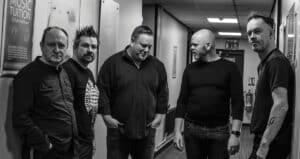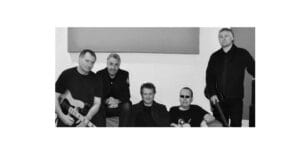Pallas: Scotland’s Progressive Rock Giants
Pallas is a Scottish progressive rock band formed in 1974 in Aberdeen, Scotland. As one of the pioneers of the neo-progressive rock movement, Pallas emerged alongside bands like Marillion, IQ, and Pendragon, helping to rejuvenate the progressive rock scene during the early 1980s. Their music combines elements of classic progressive rock, hard rock, and symphonic arrangements, creating a sound that’s both epic and emotionally resonant.
Pallas is known for its dramatic storytelling, conceptual themes, and dynamic performances. Their ability to blend grandiose compositions with heartfelt lyrics has made them a staple in the world of progressive rock.
1. Formation and Early Years (1974-1980s)
1.1 The Beginnings
- Pallas was formed in 1974 by a group of friends from Aberdeen who were inspired by the progressive rock boom of the 1970s, led by bands like Genesis, Yes, and Pink Floyd.
- The original lineup included Graeme Murray (bass), Ronnie Brown (keyboards), Colin Fraser (drums), and Niall Mathewson (guitar). Early on, the band focused on crafting long, intricate compositions with a heavy focus on storytelling.
1.2 Gaining Momentum
- By the late 1970s, Pallas had started to gain a local following, performing at clubs and festivals across Scotland. Their early music was heavily influenced by the symphonic sound of Yes and the atmospheric textures of Genesis.
2. The Neo-Progressive Era (1980s)
2.1 Arrive Alive (1981) – The Breakthrough
- In 1981, Pallas released their first album, Arrive Alive, a live recording that showcased their raw energy and compositional prowess. The album received critical acclaim and brought them to the attention of EMI Records.
- Though primarily a live album, Arrive Alive became a cult classic within the burgeoning neo-progressive rock movement, demonstrating the band’s potential to rival contemporaries like Marillion.
- Key Tracks:
2.2 The Sentinel (1984) – The Concept Masterpiece
- Pallas’s first studio album, The Sentinel, was released in 1984 and remains one of their most celebrated works. A concept album inspired by the legend of Atlantis, the album featured grandiose compositions, soaring vocals, and a mix of symphonic and rock elements.
- Produced by Eddie Offord (known for his work with Yes), The Sentinel solidified Pallas’s position as one of the leading bands in the neo-prog movement.
- Key Tracks:
- Eyes in the Night (Arrive Alive)
- Atlantis Suite
- Cut and Run
2.3 The Wedge (1986) – A New Direction
- After parting ways with vocalist Euan Lowson, Pallas brought in Alan Reed as their new frontman. The shift in vocalists led to a change in their sound, with The Wedge (1986) showcasing a more accessible, melodic approach while retaining their progressive roots.
- The album explored themes of personal struggle and social issues, offering shorter, more radio-friendly tracks without losing their progressive identity.
- Key Tracks:
- Dance Through the Fire
- Throwing Stones at the Wind
- The Executioner (Bernie’s Letter)
3. Reinvention and Resurgence (1990s-2000s)
3.1 Hiatus and Return
- After a brief hiatus in the late 1980s, Pallas returned in the 1990s, reinvigorated and ready to embrace a more modern sound. The band began experimenting with harder edges and electronic influences while staying true to their progressive foundation.
3.2 Beat the Drum (1999) – A Triumphant Comeback
- Released in 1999, Beat the Drum marked a return to form for Pallas. The album showcased a blend of modern rock elements with their classic symphonic style, exploring themes of personal and global conflicts.
- This album introduced a younger generation to Pallas’s music and reestablished their reputation as a force in progressive rock.
- Key Tracks:
- Beat the Drum
- Hide and Seek
- Fragments of the Sun
3.3 The Cross and the Crucible (2001) – A Symphonic Epic
- 2001’s The Cross and the Crucible is considered one of Pallas’s finest achievements. A concept album exploring themes of religion, science, and the human condition, it featured a rich, cinematic sound with orchestral flourishes.
- The album demonstrated the band’s ability to tackle complex themes with both musical and lyrical sophistication.
- Key Tracks:
- The Cross and the Crucible
- For the Greater Glory
- Tower of Babel
4. Later Years and Recent Work (2010s-Present)
4.1 XXV (2011) – Revisiting Atlantis
- In 2011, Pallas revisited the themes of The Sentinel with XXV, a sequel exploring the aftermath of the Atlantis myth. The album featured a heavier, more modern sound, with influences from prog-metal and electronic music.
- XXV received praise for its ambitious storytelling and dynamic compositions, reaffirming Pallas’s place in the progressive rock landscape.
- Key Tracks:
- Falling Down
- Crash and Burn
- The Last Angel
4.2 Continuing Legacy
- Despite lineup changes and the challenges of maintaining a band over decades, Pallas continues to perform and create music. Their ability to adapt while remaining true to their progressive roots has kept them relevant to both long-time fans and new listeners.
5. Pallas’s Discography Overview
Studio Albums:
- Arrive Alive (1981)
- The Sentinel (1984)
- The Wedge (1986)
- Beat the Drum (1999)
- The Cross and the Crucible (2001)
- The Dreams of Men (2005)
- XXV (2011)
- We Are Who We Are (2014)
Live Albums:
- Pallas Live (1992)
- The Blinding Darkness (2003)
- Live at Loreley (2015)
6. Pallas’s Influence on Progressive Rock
Pallas has been a crucial part of the neo-progressive movement, standing out for their ability to blend mythical storytelling with modern rock sensibilities. Their work has inspired countless progressive rock bands, and their legacy is cemented as one of the defining acts of the genre.




